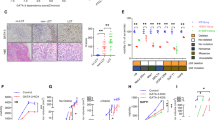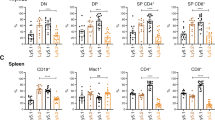Abstract
p101, the regulatory subunit of phosphatidylinositol-3-kinase-gamma (PI3Kγ), was recently reported as a common site of retroviral insertion in T-cell lymphomas induced in mice by MoFe2-MuLV, a unique recombinant gammaretrovirus. The common interruption of p101 by retroviral integration suggests that the locus encodes an oncogene whose altered expression is related to the induction of T-cell malignancy. To examine a possible role in the malignant process, p101 was overexpressed in human T-cell lines Molt-4 and Jurkat. Transient overexpression of p101 induced apoptosis in recipient cells; however, stable expression could be established in cells that expressed moderate levels of p101. Constitutive p101 overexpression in those cells conferred significant protection against ultraviolet-induced apoptosis. Protection against apoptotic induction was attributed to p101-mediated activation of the Akt pathway. Constitutive overexpression of p101 enhanced the activity of p110γ and further sensitized it to activation upon stimulation of G protein-coupled receptor. These findings are the first to implicate altered expression of p101 in malignancy, specifically in T-cell lymphoma. The findings further provide insight into the regulation of p110γ, indicating that the stoichiometry of p110γ and p101 are important in regulating PI3Kγ signaling.
This is a preview of subscription content, access via your institution
Access options
Subscribe to this journal
Receive 50 print issues and online access
$259.00 per year
only $5.18 per issue
Buy this article
- Purchase on Springer Link
- Instant access to full article PDF
Prices may be subject to local taxes which are calculated during checkout






Similar content being viewed by others
References
Abdel-Mageed A, Agrawal KC . (1997). Antisense down-regulation of metallothionein induces growth arrest and apoptosis in human breast carcinoma cells. Cancer Gene Ther 4: 199–207.
Bader AG, Kang S, Vogt PK . (2006). Cancer-specific mutations in PIK3CA are oncogenic in vivo. Proc Natl Acad Sci USA 103: 1475–1479.
Brock C, Schaefer M, Reusch HP, Czupalla C, Michalke M, Spicher K et al. (2003). Roles of G beta gamma in membrane recruitment and activation of p110 gamma/p101 phosphoinositide 3-kinase gamma. J Cell Biol 160: 89–99.
Cairns P, Okami K, Halachmi S, Halachmi N, Esteller M, Herman JG et al. (1997). Frequent inactivation of PTEN/MMAC1 in primary prostate cancer. Cancer Res 57: 4997–5000.
Campbell IG, Russell SE, Choong DY, Montgomery KG, Ciavarella ML, Hooi CS et al. (2004). Mutation of the PIK3CA gene in ovarian and breast cancer. Cancer Res 64: 7678–7681.
Curnock AP, Logan MK, Ward SG . (2002). Chemokine signalling: pivoting around multiple phosphoinositide 3-kinases. Immunology 105: 125–136.
Foukas LC, Daniele N, Ktori C, Anderson KE, Jensen J, Shepherd PR . (2002). Direct effects of caffeine and theophylline on p110 delta and other phosphoinositide 3-kinases. J Biol Chem 277: 37124–37130.
Freeburn RW, Wright KL, Burgess SJ, Astoul E, Cantrell DA, Ward SG . (2002). Evidence that SHIP-1 contributes to phosphatidylinositol 3,4,5-trisphosphate metabolism in T lymphocytes and can regulate novel phosphoinositide 3-kinase effectors. J Immunol 169: 5441–5450.
Goel A, Arnold CN, Niedzwiecki D, Carethers JM, Dowell JM, Wasserman L et al. (2004). Frequent inactivation of PTEN by promoter hypermethylation in microsatellite instability-high sporadic colorectal cancers. Cancer Res 64: 3014–3021.
Grandori C, Cowley SM, James LP, Eisenman RN . (2000). The Myc/Max/Mad network and the transcriptional control of cell behavior. Annu Rev Cell Dev Biol 16: 653–699.
Hennessy BT, Smith DL, Ram PT, Lu Y, Mills GB . (2005). Exploiting the PI3K/AKT pathway for cancer drug discovery. Nat Rev Drug Discov 4: 988–1004.
Hickey FB, Cotter TG . (2006). BCR-ABL regulates phosphatidylinositol 3-kinase-p110gamma transcription and activation and is required for proliferation and drug resistance. J Biol Chem 281: 2441–2450.
Hirsch E, Katanaev VL, Garlanda C, Azzolino O, Pirola L, Silengo L et al. (2000). Central role for G protein-coupled phosphoinositide 3-kinase gamma in inflammation. Science 287: 1049–1053.
Jimenez C, Jones DR, Rodriguez-Viciana P, Gonzalez-Garcia A, Leonardo E, Wennstrom S et al. (1998). Identification and characterization of a new oncogene derived from the regulatory subunit of phosphoinositide 3-kinase. EMBO J 17: 743–753.
Johnson C, Lobelle-Rich PA, Puetter A, Levy LS . (2005). Substitution of feline leukemia virus long terminal repeat sequences into murine leukemia virus alters the pattern of insertional activation and identifies new common insertion sites. J Virol 79: 57–66.
Jucker M, Sudel K, Horn S, Sickel M, Wegner W, Fiedler W et al. (2002). Expression of a mutated form of the p85alpha regulatory subunit of phosphatidylinositol 3-kinase in a Hodgkin's lymphoma-derived cell line (CO). Leukemia 16: 894–901.
Kang S, Bader AG, Zhao L, Vogt PK . (2005). Mutated PI 3-kinases: cancer targets on a silver platter. Cell Cycle 4: 578–581.
Kang S, Denley A, Vanhaesebroeck B, Vogt PK . (2006). Oncogenic transformation induced by the p110beta, -gamma, and -delta isoforms of class I phosphoinositide 3-kinase. Proc Natl Acad Sci USA 103: 1289–1294.
Khan S, Kumagai T, Vora J, Bose N, Sehgal I, Koeffler PH et al. (2004). PTEN promoter is methylated in a proportion of invasive breast cancers. Int J Cancer 112: 407–410.
Okkenhaug K, Vanhaesebroeck B . (2003). PI3K in lymphocyte development, differentiation and activation. Nat Rev Immunol 3: 317–330.
Samuels Y, Velculescu VE . (2004). Oncogenic mutations of PIK3CA in human cancers. Cell Cycle 3: 1221–1224.
Sasaki T, Irie-Sasaki J, Jones RG, Oliveira-dos-Santos AJ, Stanford WL, Bolon B et al. (2000). Function of PI3Kgamma in thymocyte development, T cell activation, and neutrophil migration. Science 287: 1040–1046.
Shayesteh L, Lu Y, Kuo WL, Baldocchi R, Godfrey T, Collins C et al. (1999). PIK3CA is implicated as an oncogene in ovarian cancer. Nat Genet 21: 99–102.
Stephens L, Smrcka A, Cooke FT, Jackson TR, Sternweis PC, Hawkins PT . (1994). A novel phosphoinositide 3 kinase activity in myeloid-derived cells is activated by G protein beta gamma subunits. Cell 77: 83–93.
Stephens LR, Eguinoa A, Erdjument-Bromage H, Lui M, Cooke F, Coadwell J et al. (1997). The G beta gamma sensitivity of a PI3K is dependent upon a tightly associated adaptor, p101. Cell 89: 105–114.
Suire S, Coadwell J, Ferguson GJ, Davidson K, Hawkins P, Stephens L . (2005). p84, a new Gbetagamma-activated regulatory subunit of the type IB phosphoinositide 3-kinase p110gamma. Curr Biol 15: 566–570.
Vanhaesebroeck B, Alessi DR . (2000). The PI3K-PDK1 connection: more than just a road to PKB. Biochem J 346: 561–576.
Vanhaesebroeck B, Welham MJ, Kotani K, Stein R, Warne PH, Zvelebil MJ et al. (1997). P110delta, a novel phosphoinositide 3-kinase in leukocytes. Proc Natl Acad Sci USA 94: 4330–4335.
Voigt P, Brock C, Nurnberg B, Schaefer M . (2005). Assigning functional domains within the p101 regulatory subunit of phosphoinositide 3-kinase gamma. J Biol Chem 280: 5121–5127.
Voigt P, Dorner MB, Schaefer M . (2006). Characterization of p87PIKAP, a novel regulatory subunit of phosphoinositide 3-kinase gamma that is highly expressed in heart and interacts with PDE3B. J Biol Chem 281: 9977–9986.
Woenckhaus J, Steger K, Werner E, Fenic I, Gamerdinger U, Dreyer T et al. (2002). Genomic gain of PIK3CA and increased expression of p110alpha are associated with progression of dysplasia into invasive squamous cell carcinoma. J Pathol 198: 335–342.
Acknowledgements
We acknowledge the valuable advice and assistance of Aline Scandurro, Kent Buchanan and Chandtip Chandhasin. This work was supported by PHS grant CA83823 from the National Cancer Institute, by a grant from the Ladies Leukemia League and by Support Funds of the Louisiana Cancer Research Consortium. Chassidy Johnson was supported in part by grants from the Cancer Association of Greater New Orleans and the American Association for Cancer Research Save the Science Fund.
Author information
Authors and Affiliations
Corresponding author
Rights and permissions
About this article
Cite this article
Johnson, C., Marriott, S. & Levy, L. Overexpression of p101 activates PI3Kγ signaling in T cells and contributes to cell survival. Oncogene 26, 7049–7057 (2007). https://doi.org/10.1038/sj.onc.1210504
Received:
Revised:
Accepted:
Published:
Issue Date:
DOI: https://doi.org/10.1038/sj.onc.1210504
Keywords
This article is cited by
-
The proprotein convertase furin is a pro-oncogenic driver in KRAS and BRAF driven colorectal cancer
Oncogene (2020)
-
p84 forms a negative regulatory complex with p110γ to control PI3Kγ signalling during cell migration
Immunology & Cell Biology (2015)
-
Differential roles for the p101 and p84 regulatory subunits of PI3Kγ in tumor growth and metastasis
Oncogene (2012)



